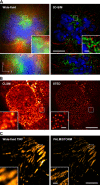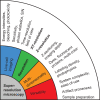A guide to super-resolution fluorescence microscopy
- PMID: 20643879
- PMCID: PMC2918923
- DOI: 10.1083/jcb.201002018
A guide to super-resolution fluorescence microscopy
Abstract
For centuries, cell biology has been based on light microscopy and at the same time been limited by its optical resolution. However, several new technologies have been developed recently that bypass this limit. These new super-resolution technologies are either based on tailored illumination, nonlinear fluorophore responses, or the precise localization of single molecules. Overall, these new approaches have created unprecedented new possibilities to investigate the structure and function of cells.
Figures





References
-
- Abbe E.1873. Beiträge zur Theorie des Mikroskops und der mikroskopischen Wahrnehmung. Archiv für mikroskopische Anatomie. 9:413–418
-
- Baddeley D., Chagin V.O., Schermelleh L., Martin S., Pombo A., Carlton P.M., Gahl A., Domaing P., Birk U., Leonhardt H., et al. 2010. Measurement of replication structures at the nanometer scale using super-resolution light microscopy. Nucleic Acids Res. 38:e8 10.1093/nar/gkp901 - DOI - PMC - PubMed
Publication types
MeSH terms
Substances
LinkOut - more resources
Full Text Sources
Other Literature Sources

